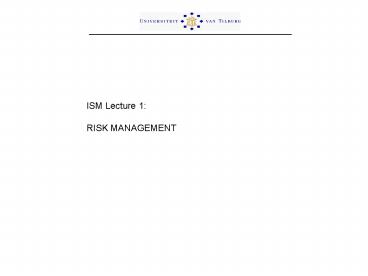ISM Lecture 1: - PowerPoint PPT Presentation
1 / 35
Title:
ISM Lecture 1:
Description:
Uncertainty exists when do not know the future ... Uncertainty is a necessary, but not sufficient, condition for risk ... Pecuniary. Risk Transfer ... – PowerPoint PPT presentation
Number of Views:73
Avg rating:3.0/5.0
Title: ISM Lecture 1:
1
ISM Lecture 1 RISK MANAGEMENT
2
If you dont actively attack risks, they will
actively attack you. Tom Gilb
3
(No Transcript)
4
(No Transcript)
5
(No Transcript)
6
(No Transcript)
7
- To be considered a risk, there must be
- A loss association with it
- Uncertainty or chance involved
- Some choice involved
8
Terminology
- Uncertainty exists when do not know the future
- Risk is uncertainty that is relevant to you, i.e.
it will affect your welfare - Uncertainty is a necessary, but not sufficient,
condition for risk - Every risky situation is uncertain, but there can
be uncertainty without risk
9
Probability is the likelihood that the Risk Event
will occur, e.g., 30 chance of rain
10
Risk Utility
- Risk utility or risk tolerance is the amount of
satisfaction or pleasure received from a
potential payoff - Utility rises at a decreasing rate for a person
who is risk-averse - Those who are risk-seeking have a higher
tolerance for risk and their satisfaction
increases when more payoff is at stake - The risk neutral approach achieves a balance
between risk and payoff
11
Figure 10-1. Risk Utility Function and Risk
Preference
12
11
Examples of Risk
13
The Wheel of Misfortune
Fig 24-1
14
Risk classifications
Property Risks
Customer Risks
Personnel Risks
Fire
EmployeeDishonesty
On-PremisesInjury
Natural DisastersActs of God
Competition fromFormer Employees
Product Liability
Burglary andBusiness Swindles
Loss of KeyExecutives
Bad Debts
Shoplifting
Bankruptcy
15
Risk analysis and risk management
16
Goal of Risk Management
- The goal of risk management is not to eliminate
all of the risks, but rather to create an
environment where the inherent risks within the
activities and services provided by an
organization, and also the surrounding risks are
minimized without producing a change in the
activity itself - To eliminate all risks would be to give up all
activities!!!!
17
Introduction
Risk Analysis
Risk Management
Risk Identification
Risk Planning
Risk Estimation
Risk Control
Risk Evaluation
Risk Monitoring
18
Risk Analysis
Risk Identification
What is the risk? How it can be categorize?
What is the size of the risk? What is exposed to
the risk? What is the risks likelihood of
occurring?
Risk Estimation
What is considered an acceptable risk? What is
the exposure to risk? Is the risk
acceptable? What other choices exist to avert the
risk?
Risk Evaluation
19
Risk Management
20
Risk Management Cycle I
Risk Monitoring
Risk Identification
Risk Analysis
Risk Handling
21
Risk Management Cycle II
22
Risk Management Process
- Risk Identification
- Risk assessment
- Selection of risk-mgmt techniques
23
Risk Management Process
- Risk identification deducing most important risk
exposures - Risk assessment quantification of costs
associated with the risks identified actuaries
at insurance companies do this by gathering and
analyzing data to estimate probabilities of
illness, accident, flood, theft, etc.
24
Risk Management Process
- Risk Mgmt Techniques
- Risk avoidance avoid exposure to that risk
- Loss prevention and control actions taken to
reduce likelihood or severity of loss - Risk retention absorbing the risk and covering
the losses using own resources - Risk transfer transferring the risk to others by
selling a risky asset and buying insurance
25
Controlling Phase Averting Strategies
26
Risk Transfer
- Most basic method of transferring risk is by
selling the asset that is the source of the risk - But if want to keep that asset, there are three
methods for transferring risk
27
Risk Transfer
- Diversifying holding similar amounts of many
risky assets instead of concentrating all
investment in only one typically choose several
(risky) assets that are uncorrelated so as to
reduce risk to a single one
28
- Risk planning means preparing a strategy to deal
with each of the risks identified - Classes of strategies
- Avoidance strategies the probability of the risk
will be diminished - Minimization strategies the effect of the risk
will be reduced - Contingency strategies plans for the worst case
scenarios
29
What is a Risk Management Plan?
- A plan that analyzes the services offered for
personal injury and financial loss potential and
selects approaches to handle such losses
30
Risk Management Plan Objectives
- Loss control
- Preventing damage or destruction of property
- Reducing or preventing possible injury
- Instituting loss-reducing programs
- Shifting the losses that cannot be controlled
through transfer
31
Risk Management Planning
- The main output of risk management planning is a
risk management plan - The project team should review project documents
and understand the organizations and the
sponsors approach to risk - The level of detail will vary with the needs of
the project
32
Questions Addressed in a Risk Management Plan
33
Contingency and Fallback Plans, Contingency
Reserves
- Contingency plans are predefined actions that the
project team will take if an identified risk
event occurs - Fallback plans are developed for risks that have
a high impact on meeting project objectives - Contingency reserve or allowances are provisions
held by the project sponsor that can be used to
mitigate cost or schedule risk if changes in
scope or quality occur
34
(No Transcript)
35
(No Transcript)

